QuestionA few weeks ago we got a MHD from a friend who kept it in a 10 gallon tank. They had it two years and never had any problems. We got it and put it in a 40 gal. tank. After reading some of your info., I realize it needs a tall tank in stead of our long one. The MHD now looks very week and has a few white spots around his head. Does not cling to you or the tree in the cage like it used to. How can we nurse it back to health? What is the best type of water bowl/container to use (is tupperware O.K.?) We wonder if it is having a hard time catching its' crickets since it is in a longer tank and we put in crickets we caught instead of bought ones from the store. We also had the water at the opposite end of where the tree was and wondered if he had trouble moving from one end to the other since it was a glass surface. (We recently purchased coconut bedding). We also have a fogger. Should we be using it? We also have a heat lamp and an infarred lamp. They had previously just used a fish tank long-flourescent light during the day and nothing at night. Lastly, if we get a tall cage, should it be made of mesh or wire, or does it need to be enclosed to keep it moist? Can we use a dead limb from outside or is it best to purchase synthetic from the pet store? Is there a big chance that it will die or is it possible to get them healthy again when they are so weak? Please help. Thank you so much. Laura
AnswerHi Laura,
With most lizards they do go through a stress period when their ownership or other things change. You don't say how old the MHD is and if he was never provided with the proper uvb lighting, his weakened condition can also be metabolic bone disease.
The best advice is to have your pet checked out by a vet that is able to treat reptiles. Having a fecal check done for internal parasites is always recommended as that stress can cause overloads of parasites(all lizards have parasites basically, and actually need a low level of them, but when stressed, the load can be too great and medications are needed...never use ivermection on a MHD) to find a vet that is able to treat reptiles,
http://www.arav.org/Directory.htm
http://www.anapsid.org/vets/
Now..on to your questions!!!!
The problem with open wire cages with insect eating lizards is the insects escaping through the wire. If a small enough mesh is used, that problem is solved but the fine mesh is hard on their claws and they can tear claws out plus, the finer the mesh, the more uvb is blocked..BUT...their uvb source can be mounted to the inside of the cage. Wire mesh is harder to keep the needed humidity at the proper levels of 70-80%. If you, or a family member is handy with building things, using old window sashes or storm windows work wonderfully for making enclosed cages. With a mesh, using clear plastic shower curtains to "wrap" the cage helps with humidity...but be sure that their is sufficient ventilation also.
Plastic isn't as easily cleaned as a ceramic is. Your water area needs to be able to allow the MHD to get into it as they do enjoy a swim and soaking. It also needs to have movement such as a filter or air stone as a MHD will not drink from standing water. Waterfalls work nicely for their "drinking dish".
Since he was housed in such a small tank prior to you getting him, he may have gotten used to just chasing his food in a small area and gives up or tires with the larger area, but that should not happen with a healthy dragon. Its not a good idea to feed any insects from outdoors as that we really have no idea where that insect was before it came into our yards. Coming from other areas, they may be covered with pesticides, fertilizers, etc. Its best to only feed purchased insects that we know are free of any possible contamination from the outdoors. If he seems to be having problems chasing/catching crickets, try offering other insects such as earthworms,and other insects listed in the care info link. You can also break the hind legs off the crickets which will prevent the crickets from hopping away...sounds gross but its one of the things I have to do for one of my leopard geckos that has a problem with her eyes.
For dusting the insects, Use a calcium with no added phosphorus.
Insects must be gut loaded(fed) for at least 48 hours prior to feeding your MHD. Remove any uneaten crix or insects after 15-20 minutes..... Place a piece of cut potato in the cage so that if you have missed any uneaten insects, they will eat the potato instead of nibbling on your dragon!!!
*************You have to be sure to feed your crickets and insects the right foods
before feeding them to your gecko. If your crickets/insects are not healthy and well fed, your dragon will not get the nutrition
he needs. You can gut load your crickets and insects greens, veggies, cereals or specially designed commercial foods for crickets or the insects you are feeding. ************
A fogger is a WONDERFUL thing for a MHD!!! They love them!!
You may have too much heat on your dragon... Their warmest area only needs to be about 80 degrees... low temps 70 degrees at the lowest(daytime cool and nighttime)
I've included information on the proper uvb that is needed for the dragon.
UVB is provided By special lights
that come in fluorescent tubes or special screw in bulbs
(mercury vapor)that are designed to produce uvb and heat.
The tubes do not produce heat.(Tubes are the best for the MHD as they don't need the heat that a mercury vapor produces) UVB is needed by the MHD
to be able to absorb the calcium in the foods they eat.
With out the uvb, they will develop metabolic bone disease.
With the tubes, they must say that they produce BOTH uvb and
uva. The uvb needs to be 5% or higher. Repti Sun 10.0 and the Repti Glo 8.0's
are a great source for uvb. The old "favorites" are the repti sun 5.0 or the
Iguana light..which are the same tube, just different package.
There are tubes
that say ''full spectrum'' but they do not produce any uvb.
These need to be positioned 6-8 inches over the iguana for the 5% and 8%
and 8-10 inches for the 10% so
that they get the uvb that is needed. The tubes need to be replaced every 6-9
months as that they stop producing UVB long before they stop producing
light.
Do not use coil lights that are sold as
that they do not produce the uvb in the fashion needed for MHD's.
They do not need any night time lighting and generally normal room temperatures are fine.
The coconut bedding is fine...but..I would use just plain newspaper until a vet check and fecal is done..this way you will be able to see any oddness in the stools, and its much easier to clean the newspaper...the loose substrates can harbor the parasites and their eggs too easily when the parasite load is great.
On an outdoor branch, yes they are fine to use but must be properly treated/cleaned prior to placing in the cage. All items brought from outside need to be cleaned well before placing them in the dragons cage. To clean them, there are a few methods: to wash in a bleach solution of 1/4 cup of bleach to 1 gallon of water. Let them soak for about an hour, rinse them in hot water several times and then let them dry in the sun until completely dry. If the items are small enough, they can be baked in an over at 200 degrees for about 2 hours, check often to be sure they are not starting to burn. The items can also be boiled(simmered) for 30 minutes or so and then allowed to dry completely before placing in the tank.
to keep the cage warm in an area, you can use any household lightbulb in a wattage needed to get the proper temperatures. Using a good digital thermometer is important. Acu Rite is a good brand...around 10-15$ at wal mart..they measure two different temperatures plus humidity.. The infrared lights might be too much heat for the dragon and they don't do well with too high of temps..(over 80)Remember, you want the cage to have a gradient(slowly rising) temperature ranging from 70-80 degrees.
The white spots can be several things... areas that are getting ready to shed or a bacterial or fungal infection...again, best to get him checked out by a vet. Reptiles are fairly tough and when the proper treatment is given for a problem, they generally bounce back pretty well. Much will depend on the age of the dragon. If he is calm and fine with you holding him, you might want to take him outdoors for some real sunshine...don't keep him in the full sun, but under a covering of a tree...which sunshine will filter through the leaves which is very natural for them.
http://www.froggieb.com/MHDCaresheet.html is a good link for more info.
Sorry this is so long but I wanted to cover as much as possible with you on your questions...please do keep me informed as to how he is doing!!!

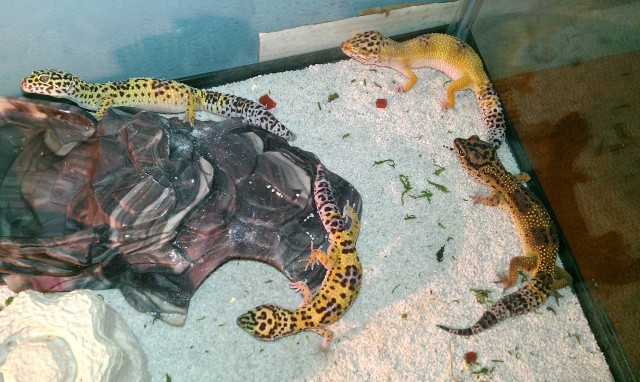 My Leopard Gecko doesnt seem to be eating
Question
My Geckos
First off, I would personally
My Leopard Gecko doesnt seem to be eating
Question
My Geckos
First off, I would personally
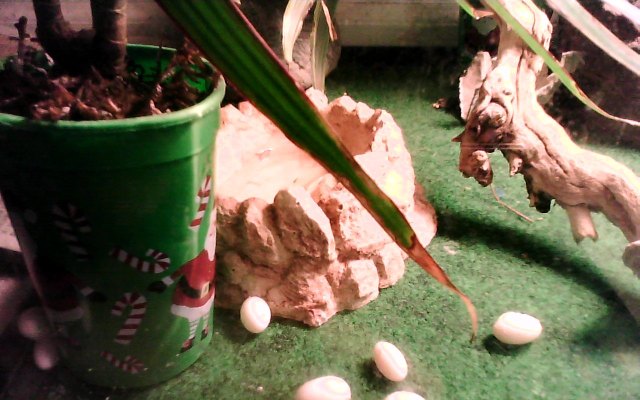 MHD eggs
Question
My MHDs eggs
Hi! My MHD layed eggs not
MHD eggs
Question
My MHDs eggs
Hi! My MHD layed eggs not
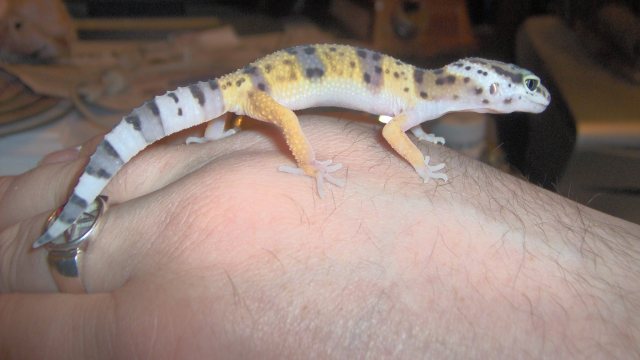 Leopard Geckos and Marking Territory
Question
My leo
Hi! I have a small leopard gecko who I
Leopard Geckos and Marking Territory
Question
My leo
Hi! I have a small leopard gecko who I
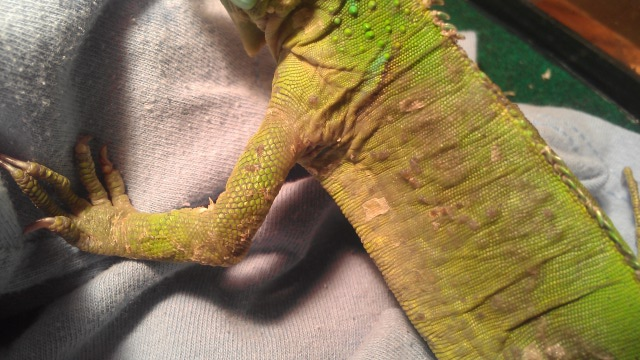 Black and red blisters/bumps on my iguana
Question
black bumps under his belly
hello
Black and red blisters/bumps on my iguana
Question
black bumps under his belly
hello
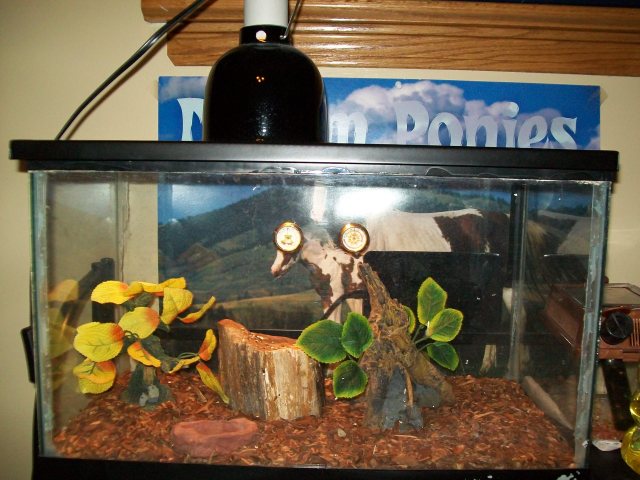 questionable sick green anole
QuestionQUESTION: Hi, I currently have a female green a
questionable sick green anole
QuestionQUESTION: Hi, I currently have a female green a